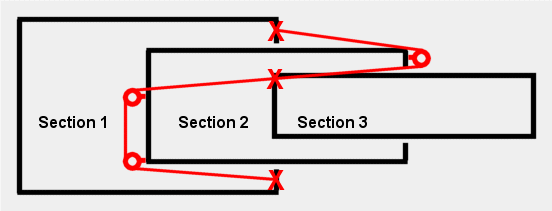Mobile AT Crane 6x4x2
First serious mobile crane, features a full pendular suspension, 3-speed gearbox gearbox and 3-section telescopic boom.
Datasheet:
Completion date: 02/06/2007
Power: electric (wire-controlled) / pneumatic (fed from internal manual pump)
Dimensions: length 61 studs / width 20 studs / height unknown
Weight: 2.34 kg
Suspension: full pendular
Motors: 1 x RC, 1 x 71427, 1 x 2838
Pneumatics: 2 circuits with an airtank
The result of my fascination on the 8421 set (which I didn’t have yet at that time), the Mobile AT Crane (AT stands for All-Terrain) was my first serious take on the subject of the mobile cranes. Despite somewhat limited resources, it has many functions, works well, and bears some degree of a resemblance to some real machine. It’s fitted with pendular suspension that needs no shock absorbers for stability, because it uses a transverse module in front and longitudinal rocking arms in rear. The drivetrain consists of an RC motor with huge gear reduction (including a worm screw) and a manual linear 3-speed gearbox.The V8 piston engine on the top of the crane is driven by the same motor. Once again, the use of a chain (directly after the gearbox) proved a good idea. The drive is transfered by a single differential to the 4 rear wheels. A noticeable feature is the Ackermann steering geometry, which pretty much defined the size of the crane by limiting its wheelbase. The steering wheel in the cabin is functional. One of the videos shows the crane towing a trailer with approx. 8 kilograms of load – an achievement beyond the range of many of my later constructions.
The 2838 motor is used for steering, and the 71427 powers the superstructure. Note that the latter motor is located not in the superstructure, but in the hull, under the turntable that has a vertical axle transfering the drive inside. Within the superstructure is a simple linear distributive gearbox, which makes it possible for the motor to drive either the winch or the boom extension mechanism. The latter function doesn’t work so well, however, due to insufficient motor’s torque, as well as its drivetrain not being stiff enough.
The boom consists of 3 sections built entirely from liftarms. Its sides are completely uncovered, which helped to reduce the weight but made the boom more likely to bend under load. The extension mechanism uses the idea developed by Jennifer Clark, where the middle section is extended by the rack and pinion mechanism, and the third section follows its movement thanks to a system of pulleys. This solution turned out to work quite well, despite its assembly being troublesome, and despite the string being exposed to really strong forces. It is easy to understand how it works from the diagram below, if you note that X marks places where the string is attached, and the red rings mark the pulleys. Thus, if you extend or retract section 2, section 3 will follow it immediately.

The crane has very limited load capacity, even though I used a burton to lift the hook. The most likely reason is the construction of the boom, which is too weak for its length. Limiting the boom to 2 sections would certainly improve its performance.
Pneumatics, finally, includes a manual pump located in the rear part of the hull, near the gearbox. The pump is connected to an internal airtank, and the airtank is connected to two manual valves. One of the valves controls 4 cylinders that deploy 4 outriggers on the sides of the crane, and the second valve controls 2 cylinders that raise the boom. Note that these 2 cylinders are connected to the boom by a pair of shock absorbers. It’s basically intended to stop the cylinders from rotating (just like in the 8421 set), and I was hoping that it would help the boom to go down a little bit more gently.
Photos:
Videos:











































@Mike
Most likely two coupled XL motors. Or perhaps four.
@Sariel
Well then, this suits the work all nite, don’t eat principle 😉 what’s going to drive it? An Xl motor hooked up to 220 volts AC? 🙂
@Mike
I’m going to build a pushback tug, and the goal is to make it tow a chair with me sitting on it 🙂
Amazing what this could pull… everything but the kitchen sink 🙂
I wish you built things like this again!
TY geniusz!!! 🙂
@aaron
No, I don’t. Look up the Ackermann steering definition in for instance the Wikipedia, it should be easy to build once you get the idea. However, I have dropped the idea of using the Ackermann steering in Lego vehicles – it is simply not needed at a scale this small, and it only leads to a needless complexity.
do you have any instructions for your ackermann steering design ?
i found some pictures of it on brickshelf so ill try to copy from that =)
please reply and tell me if you have any instructions for it anywhere
thanks,
aaron
=)
@Eric Albrecht
Well I don’t really remember, it was long ago.
I like everything about this creation except for the Bionicle hook. 😉
This thing is truly massive. Based on the scale size of the seats, it looks like this vehicle would cover 3 lanes of traffic. Even though the base structure is very blocky, I like the studded construction.
I’m surprised that two pneumatic cylinders in series were able to lift that boom. I typically see 2 series, 2 parallel for a crane this size. Can it still lift the boom even if it is extended? 8421 has a very hard time of this. Jennifer Clark’s JCB JS220 uses 4 cylinders even with a much shorter arm.